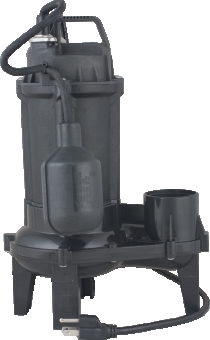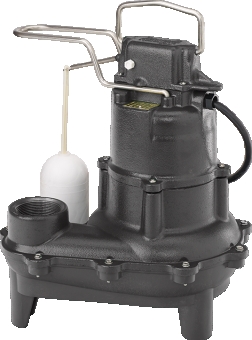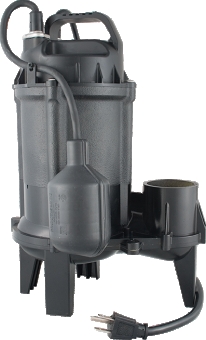
30TC Cast Iron Sewage Pump
30TC 1/3 HP submersible sewage ejector sump pump with epoxy coated cast iron design that features bottom suction inlet with non-clogging vortex impeller easily passes 2 inch solids.

40EC Cast Iron Sewage Pump
40EC 0.4 HP Epoxy-coated, cast iron sewage pump designed to dissipate motor heat to ensure long life.

50TC Cast Iron Sewage Pump
50TC 1/2 HP cast iron sewage sump pump with epoxy coated cast iron design that dissipates motor heat to ensure long life.
Household Sewage Removal
If your home is above grade, your sewer system will use gravity to push the wastewater downhill into a sewer line or septic tank. However, if your home is below the septic or sewage line, you will need to install a sewage pump to remove liquid and solid sewage from your home safely.
At Star Water Systems, our cast-iron sewage pumps set the standard for reliability and quality to provide a durable, long-term sewage removal solution.
What Does a Sewage Pump Do?
A sewage pump moves solids and liquids from one place to a sewer system or septic tank. Sewage pumps use centrifugal force to pass solids without clogging the pump. After the pump turns on, the motor will begin to rotate the impeller. This motion will create pressure and push the water into the impeller before moving into a discharge pipe.
Difference Between a Sewage Pump and a Sump Pump
While sewage pumps and sump pumps are both tools for moving water out of the basement of your home, a sewage pump features a special design to handle waste. Sewage pumps feature seals that consist of wear-resistant silicon carbide to efficiently handle solids, making them ideal for pumping out water and waste in basements and bathrooms. On the other hand, a sump pump’s main purpose is to prevent flooding.
What Is the Best Residential Sewage Pump for My Home?
As you shop for different home sewage pumps, it’s important to consider critical factors such as the construction of the pump and the required motor size. Some key features to keep in mind include:
Material
Your sewage pump will spend most of its time in wastewater, making it essential to look for a pump and impeller made with durable materials. Since water and solid waste pass through the impeller, it must be strong enough to withstand these high volumes without slowing the system or needing repair. Star Water Systems makes all sewage pumps and impellers with cast iron for a heavy-duty solution.
Size and Weight
Size is another consideration since you must ensure your sewage pump will fit into your home’s septic pit or wastewater bin. You should also consider the input and output of your sewage pump to prevent clogs. Residential sewage pumps require at least 2 inches for the input and output of the pump to move solid waste up to 2 inches in diameter.
Horsepower
The horsepower of a sewage pump determines the volume of sewage your pump can process daily. If you have a larger home, you will need more horsepower to meet daily demand. At Star Water Systems, our pumps range from ¼ to ½ horsepower and meet the demands of most home sizes.
Gallons Per Hour
The gallons per hour (GPH) rating indicates the volume of wastewater your sewage pumps can move within an hour. This number depends on the pump’s horsepower and the elevation rate between the main sewage line and the pump. Sewage pumps from Star Water Systems offer rates between 4,560 GPH and 7,860 GPH.
Purchase a Home Sewage Pump From Star Water Systems
Explore high-quality sewage pumps for your home at Star Water Systems. Use our retailer locator to browse our collection today!
 Buy Now at Lowes
Buy Now at Lowes